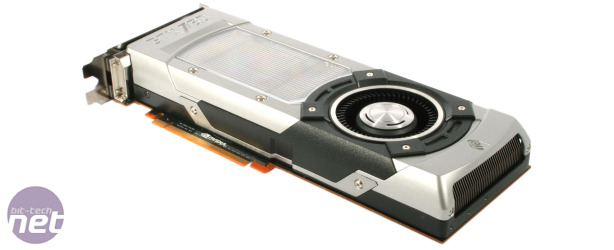
Performance Analysis
With 50 per cent more stream processors than the GTX 680 2GB and clock speeds that match those of the GTX Titan, The GTX 780 3GB is understandably quick throughout our array of benchmarks. In BF3 at 2,560 x 1,600 its minimum frame rate of 55fps represents a 37 per cent increase over the GTX 680, and is just 5fps behind the GTX Titan’s 60fps.It’s the same story in [ur;=4]Bioshock Infinite[/url]. At 2,560 x 1,600 the GTX 780 leaves the GTX 680 and the HD 7970 3GB GHz Edition in its dust, with a minimum frame rate of 49fps to the 680’s 36fps. This is only 5fps (10 per cent) behind the 54fps of the GTX Titan in the same test. At 5,760 x 1,080 the GTX 780 3GB also demonstrates the advantage of a high-end single-GPU car; While the GTX 780 produces a playable 29fps minimum frame rate the GTX 690 4GB chugs its way to a driver-crippled 7fps minimum.
Click to enlarge
Crysis 3 is just a monster of a game to run at its maximum settings, even without the addition of anti-aliasing, but GTX 780 continues to impress, with a minimum frame rate of 57fps at 1,920 x 1,080 just 4fps behind that of the GTX Titan and 22 per cent faster than the GTX 680 2GB in the same test. The GTX 780 even manages to keep frame rates respectable at 2,560 x 1,600 with a minimum frame rate of 32fps.
AMD’s latest drivers have evened the field in Skyrim a great deal, but with no like-for-like competitor the GTX 780 is able to run riot, producing prodigious frame rates at all three of our test resolutions. At 1,920 x 1,080 its minimum frame rate of 105fps matched that of GTX Titan which actually proved faster than AMD’s HD 7990 6GB, while at 2,560 x 1,600 a result of 81fps was just five per cent slower than GTX Titan in the same test. At 5,760 X 1,080 GTX 780’s minimum frame rate of 48fps was, remarkably, faster than both the multi-GPU cards on test, although the GTX 690 and HD 7990 produce identically superior average frame rates.
Click to enlarge
It’s perhaps clearest in Unigine’s Valley Benchmark where GTX 780 lies in comparison to its predecessors. A Score 2298 points is 29 per cent faster than the GTX 680 2GB it replaces in the product stack, while still sitting 10 per cent behind the performance of GTX Titan. However, as we discovered when overclocking, this gap is fairly simple to close with a few cranks of the base and memory clocks; certainly the GTX 780 is far closer to Titan than it is to GTX 680, despite the naming nomenclature.
Due to GTX 780 using what amounts to a GTX Titan Cooler and PCB, its thermal performance and power consumption are also very similar. A peak power consumption of 344W in Crysis 3 is 8W behind Titan, while the cooler’s thermal profiles are very similar, keeping the GPU temperature at 79°C by default – 59°C above ambient. At stock the card is, like Titan, very quiet, but will sacrifice clock speed to maintain temperature and noise levels if needs be. Overclocked things were much noisier, with the sound of the cooling fan clearly rising above our lab’s background.

MSI MPG Velox 100R Chassis Review
October 14 2021 | 15:04










Want to comment? Please log in.